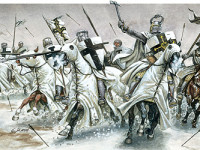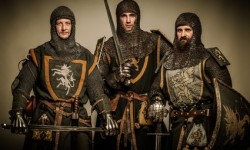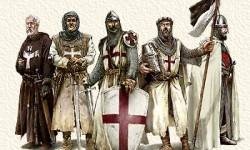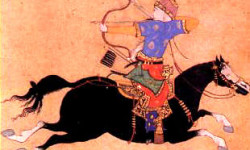With the capture of Jerusalem in 1099 and the founding of many small states such as the Principality of Antioch, the County of Edessa or the Kingdom of Jerusalem, the Christian crusaders were at the height of their power in the Middle East in the late 11th and early 12th centuries.
However, it soon became clear that the Order of the Knights Templar, which was founded specifically to protect the conquered territories, would not be able to cope with the growing onslaught of Islamic attacks. In 1144, when the county of Edessa was defeated and lost to a Seljuk attack, the second crusade ended in chaos, and in 1187 the city of Jerusalem fell into enemy hands, the third crusade was declared.
This was equipped by troops of European rulers Richard I Lionheart of England, Philip II of France and the German Emperor Frederick I Barbarossa. In 1189, the German Emperor Frederick left for the troops of the other two rulers in the direction of the Middle East months before. On the way there, the ruler drowned in the river Saleph, whereupon the German army largely disintegrated. His son and successor Duke Frederick V of Swabia then moved with only a small part of the former army further towards the city of Akko, which was besieged by King Guido of Jerusalem. This port city was important in the military planning insofar as in a reconquest of Jerusalem this would depend on replenishment by sea to the port city of Akko, since a holding of the city without supplies would not have been possible long. In 1191, the troops of Richard I and Philip II arrived, followed by the conquest of the city.
The difficult conditions of the crusade were further worsened, however, when the Austrian ruler Leopold could not agree with Richard I on the further procedure and returned to Austria. Likewise, Philip II had to leave the crusade after he had received reports of unrest in France.
Thus, Richard I stood alone in the fight against the Seljuk Turks. He led his master in August 1191 from Akko from the south to refresh his supplies. His army managed to keep the opposing troops on the march for a while at a distance, a major battle took place only on 7 September 1191, which Richard could draw no major advantage, but his reputation he could strengthen. However, his plan to conquer Jerusalem could no longer be put into action by Richard because he too was called back to his native England to take care of internal affairs. Thus ended the third crusade without significant profits.
The Fourth Crusade was mainly in the sense of profit making. Thus, the Venetian Doge Enrico Dandolo earned by sea transport and the ruler of Genoa a golden nose to the transport and logistics of the crusade. However, this ended quickly and cruelly when the troops were diverted to Constantinople and plundered there for three days, killing thousands and many things burned down.
In the fifth crusade, which was proclaimed in 1217, they tried a different tactic. this time, the troops were to pass through the area of the Aijubid in today's Egypt, attacking the Islamic area from the southwest. The campaign, however, stuck in 1221 in Egypt and the troops were defeated there devastated without even having arrived near the holy land.
The sixth crusade was led by the German Emperor Frederick II. He used diplomacy instead of the sword and negotiated the return of Jerusalem without bloodshed. However, this trade outraged the European rulers and the city was lost to the Seljuks a few years later.
The seventh crusade under King Louis IX. again tried to push the tactic from Egypt to the holy land. After initial successes, however, the army was defeated by the Mameluk Sultan Baibar and the king and his entourage were taken prisoner from which he was released only after paying a high ransom.
Despite the imprisonment of King Louis 1270 the eighth crusade began, which took him to Tunis where he died and the crusade ended.
The ninth and last Crusade was carried out by the English King Edward I in 1271, but he did not come against the Mamelukes and thus the holy land was finally lost to Islam.
You can find the right literature here:
The Concise History of the Crusades

The Concise History of the Crusades (Critical Issues in World and International History) Third Student Edition
What is the relationship between the medieval crusades and the problems of the modern Middle East? Were the crusades the Christian equivalent of Muslim jihad? In this sweeping yet crisp history, Thomas F. Madden offers a brilliant and compelling narrative of the crusades and their contemporary relevance. Placing all of the major crusades within their medieval social, economic, religious, and intellectual environments, Madden explores the uniquely medieval world that led untold thousands to leave their homes, families, and friends to march in Christ’s name to distant lands. From Palestine and Europe's farthest reaches, each crusade is recounted in a clear, concise narrative. The author gives special attention as well to the crusades’ effects on the Islamic world and the Christian Byzantine East.
The Crusades: The Authoritative History of the War for the Holy Land
The Crusades is an authoritative, accessible single-volume history of the brutal struggle for the Holy Land in the Middle Ages. Thomas Asbridge—a renowned historian who writes with “maximum vividness” (Joan Acocella, The New Yorker)—covers the years 1095 to 1291 in this big, ambitious, readable account of one of the most fascinating periods in history. From Richard the Lionheart to the mighty Saladin, from the emperors of Byzantium to the Knights Templar, Asbridge’s book is a magnificent epic of Holy War between the Christian and Islamic worlds, full of adventure, intrigue, and sweeping grandeur.
The Glory of the Crusades
How can the Crusades be called “glorious”? Our modern mindset says they were ugly wars of greed and religious intolerance—a big reason why Christians and Muslims today can’t coexist peacefully.
Historian Steve Weidenkopf challenges this received narrative with The Glory of the Crusades. Drawing on the latest and most authentic medieval scholarship, he presents a compelling case for understanding the Crusades as they were when they happened: “armed pilgrimages” driven by a holy zeal to recover conquered Christian lands. Without whitewashing their failures and even crimes, he debunks the numerous myths about the Crusades that our secular culture uses as clubs to attack the Church.
In place of these myths he offers men and women of faith and valor who pledged their lives for the honor of Christ’s holy places. With a storyteller’s gift, Weidenkopf relates the Crusades’ many dramas—their heroes and villains, battles and sieges, intrigues and coincidences—offering a vivid and engrossing account of events that, though centuries old, have profoundly affected the course of our world to the present day.
The Crusades: A History From Beginning to End
The Crusades are the prototype and epitome of the Holy War. The fight to take control of the city of Jerusalem, believed to be the most sacred Holy City to two distinct religions of Christianity and Islam, has lasted far longer than the two centuries of the Crusades and its reach has extended far further than Europe and the Middle East. Over the course of nine organized campaigns and many more unorganized ones, the Christian west militarized in the name of God to push back the threat of Islam advancing from the east.
This post is also available in:
 Deutsch (German)
Deutsch (German)  Français (French)
Français (French)  Italiano (Italian)
Italiano (Italian)  简体中文 (Chinese (Simplified))
简体中文 (Chinese (Simplified))  Русский (Russian)
Русский (Russian)  Español (Spanish)
Español (Spanish)  العربية (Arabic)
العربية (Arabic)





















